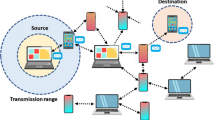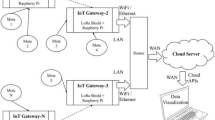Abstract
A multi-hop transitory non-central network is formed by a collection of mobile nodes in an PV Adhoc network. These mobile nodes are equipped with wireless communication transceivers. Setting up a mobile communication network is straightforward and can be done in a short amount of time. This is made possible by the fact that all nodes in the network have the same mobility and status wherever they travel. PV Adhoc networks were first developed for use in the military and the civilian sector, but they are now finding widespread application in industries as diverse as search and rescue, industrial monitoring, mobile commerce, and many more. Because of the innovative traits it possesses, there is a lot of conversation going on about it right now in the information technology and telecommunications sectors. When it comes to addressing security concerns, one might take a number of various ways, depending on the particulars of the circumstance. There are a variety of approaches that can be taken to address the concerns regarding safety that are brought up by performing multiple jobs at once. Even though quality of service (QoS) is accorded a high value in the real-world PV Adhoc network environment, it is sometimes disregarded in the research that is being done today since defense against attacks is given a higher priority. Evaluation and comparison offer the most solid foundation on which to build in-depth study and an accurate assessment of the quality of services provided. The proposed algorithm not only enhances routing security and protects against malicious attacks in PV Adhoc networks but also outperforms existing methods in terms of end-to-end delay time, packet delivery rate, and control overhead. This demonstration of improved performance and security underscores the significance and novelty of the proposed algorithm in the field. This concept is now used in a great number of different algorithms. The results of our simulation tests show that the proposed algorithm can improve the routing security of PV Adhoc networks and provide protection against malicious attacks. It also clearly outperforms other methods that are currently available in terms of end-to-end delay time, packet delivery rate, and control overhead.





Similar content being viewed by others
Data availability
Not applicable.
Code availability
Not applicable.
References
Alsamhi, S.H., Afghah, F., Sahal, R., Hawbani, A., Al-qaness, M.A., Lee, B., Guizani, M.: Green internet of things using UAVs in B5G networks: a review of applications and strategies. Ad Hoc Netw. 117, 102505 (2021)
Aruna R, D., Surendran S, D., Yuvaraj N, D., Debtera, B.: An Enhancement on Convolutional Artificial Intelligent Based Diagnosis for Skin Disease Using Nanotechnology Sensors. Comput. Intell. Neurosci., (2022).
Baidas, M.W.: Distributed energy-efficiency maximization in energy-harvesting uplink NOMA relay ad-hoc networks: game-theoretic modeling and analysis. Phys. Commun. 43, 101188 (2020)
Blondia, C.: Evaluation of the end-to-end response times in an energy harvesting wireless sensor network using a receiver-initiated MAC protocol. Ad Hoc Netw. 136, 102971 (2022)
Chenhui, W., Qingjia, M.: Design of rapid monitoring system of geological disaster based on LoRa. MATEC Web Conf. 306, 03006 (2020)
Kannan, S., Dhiman, G., Natarajan, Y., Sharma, A., Mohanty, S.N., Soni, M., Gheisari, M.: Ubiquitous vehicular ad-hoc network computing using deep neural network with iot-based bat agents for traffic management. Electronics 10(7), 785 (2021)
Kodheli, O., Maturo, N., Andrenacci, S., Chatzinotas, S., Zimmer, F.: Link budget analysis for satellite-based narrowband IoT systems. In International Conference on Ad-Hoc Networks and Wireless (pp. 259–271). (Cham: Springer, 2019).
Kousik, N., Natarajan, Y., Raja, R.A., Kallam, S., Patan, R., Gandomi, A.H.: Improved salient object detection using hybrid convolution recurrent neural network. Expert Syst. Appl. 166, 114064 (2021)
Luo, L., Sheng, L., Yu, H., Sun, G.: Intersection-based V2X routing via reinforcement learning in vehicular Ad Hoc networks. IEEE Trans. Intell.Transp. Syst. 23(6), 5446–5459 (2021)
Mehta, R.: Optimal huffman coding performance of Ad-Hoc networks based on cross-layer design. J. Inf. Sci. Eng. 36(6), 1375–1386 (2020)
Mohsan, S.A.H., Othman, N.Q.H., Khan, M.A., Amjad, H., Żywiołek, J.: A comprehensive review of micro UAV charging techniques. Micromachines 13(6), 977 (2022a)
Mohsan, S.A.H., Khan, M.A., Noor, F., Ullah, I., Alsharif, M.H.: Towards the unmanned aerial vehicles (UAVs): a comprehensive review. Drones 6(6), 147 (2022b)
Nagalakshmi, T.J., Gnanasekar, A.K., Ramkumar, G., Sabarivani, A.: Machine learning models to detect the blackhole attack in wireless adhoc network. Mater. Today Proc. 47, 235–239 (2021)
Natarajan, Y., Raja, R. A., Kousik, D. N., Johri, P.: Improved energy efficient wireless sensor networks using multicast particle swarm optimization. Available at SSRN 3555764. (2020)
Nguyen, P.D., Kim, L.W.: Sensor system: a survey of sensor type, ad hoc network topology and energy harvesting techniques. Electronics 10(2), 219 (2021)
Sadiq, B. O., Olaniyan, A. A., Ibrahim, A. A., Zakariyya, O. S.: Li-fi: The future propagation of wireless power transfer in vehicular ad hoc networks. In 2020 International Congress on Human-Computer Interaction, Optimization and Robotic Applications (HORA) (pp. 1–4). IEEE. (2020)
Sahraoui, Y., Kerrache, C.A., Amadeo, M., Vegni, A.M., Korichi, A., Nebhen, J., Imran, M.: A cooperative crowdsensing system based on flying and ground vehicles to control respiratory viral disease outbreaks. Ad Hoc Netw. 124, 102699 (2022)
Sang, Q., Wu, H., Xing, L., Xie, P.: Review and comparison of emerging routing protocols in flying ad hoc networks. Symmetry 12(6), 971 (2020)
Sharma, H., Haque, A., Jaffery, Z.A.: Maximization of wireless sensor network lifetime using solar energy harvesting for smart agriculture monitoring. Ad Hoc Netw. 94, 101966 (2019)
Tlili, F., Fourati, L.C., Ayed, S., Ouni, B.: Investigation on vulnerabilities, threats and attacks prohibiting UAVs charging and depleting UAVs batteries: assessments & countermeasures. Ad Hoc Netw. 129, 102805 (2022)
Yang, F., Zhao, C., Ding, X., Han, J.: An analytical model for energy harvest road side units deployment with dynamic service radius in vehicular Ad-Hoc networks. IEEE Access 8, 122589–122598 (2020)
Yuksel, M.E., Fidan, H.: Energy-aware system design for batteryless LPWAN devices in IoT applications. AdHoc Netw. 122, 102625 (2021)
Yuvaraj, N., Raja, R.A., Karthikeyan, T., Praghash, K.: Improved authentication in secured multicast wireless sensor network (MWSN) using opposition frog leaping algorithm to resist man-in-middle attack. Wireless Pers. Commun. 123(2), 1715–1731 (2022)
Acknowledgements
The work was supported by Researchers Supporting Project number (RSP2023R492), King Saud University, Riyadh, Saudi Arabia.
Funding
The authors have not disclosed any funding.
Author information
Authors and Affiliations
Contributions
RKK: Investigation, Methodology, Writing—review & editing. SS: Conceptualization, Formal analysis, Writing—review & editing. HKS: Conceptualization, Formal analysis, Writing—original draft Writing—review & editing. UR: Conceptualization, GR: Writing—review & editing, EAA-A: Formal analysis, Writing—review & editing. AI: Formal analysis, Writing—review & editing.
Corresponding author
Ethics declarations
Competing interests
The authors declare no competing interests.
Conflict of interest
The authors declare no competing interests.
Ethical approval
Not applicable.
Consent to participate
Not applicable.
Consent to publication
Not applicable.
Additional information
Publisher's Note
Springer Nature remains neutral with regard to jurisdictional claims in published maps and institutional affiliations.
Rights and permissions
Springer Nature or its licensor (e.g. a society or other partner) holds exclusive rights to this article under a publishing agreement with the author(s) or other rightsholder(s); author self-archiving of the accepted manuscript version of this article is solely governed by the terms of such publishing agreement and applicable law.
About this article
Cite this article
Kaushal, R.K., Sasi, S., Sowmya, H.K. et al. Design and analysis of photovoltaic solar based longer transmission of data in ADHOC networks. Opt Quant Electron 55, 1187 (2023). https://doi.org/10.1007/s11082-023-05487-0
Received:
Accepted:
Published:
DOI: https://doi.org/10.1007/s11082-023-05487-0




